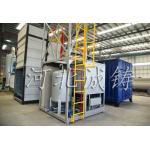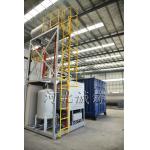Hydrolyzed Feather Meal Carbon Chicken Rendering Plant
|
|
Feather Meal Line For Shandong Linyi After the materials are loaded to the rated weight, the tank mouth is automatically closed, and the heating and pressure-increasing sterilization starts. After the temperature in the tank reaches 140 degrees (0.4Mpa), keep the pressure for 30 minutes, (the pressure and temperature can also be adjusted according to different materials), and then In the drying stage, low-temperature vacuum drying is used. After drying for 3-4 hours (adjust the drying time according to the moisture content of the material), the moisture content of the material will drop to ≤20%, and the oil content will be about 30%. Using batch processing, the entire process of feeding, cooking, drying, and discharging takes 5-6 hours. After the chemical system is dried, the automatic unloading electric control valve is opened, and the material is directly entered into the semi-finished product buffer bin through the screw conveyor. The automatic unloading electric control valve ensures that no steam overflows during discharge, and manual operation is not required. The semi-finished material is fed into the heating pot of the oil press through a screw conveyor, and then slowly enters the press chamber of the oil press for grease separation, reducing the oil content of the material to 10-12%, and obtaining meat and bone meal and grease. After the separated grease is heated and stirred by the heating and stirring tank, it enters the horizontal centrifuge, where the purified crude oil is obtained through physical centrifugation, and the crude oil enters the finished oil storage tank through the oil pump and pipeline.
Scope of application: poultry (forced moulting and prevention of pecking has a very important effect; fox and raccoon fur animals) Hydrolyzed feather meal cannot be degraded by the rumen and cannot be used in ruminants. Therefore, the state banned its use in ruminants. |
|||||||||||||||
| Product Tags: feather meal chicken rendering plant carbon chicken rendering plant Hydrolyzed feather meal rendering plant |

|
Batch Rendering Cooker Feather Meal Processing Equipment |

|
Carbon Steel Feather Meal Processing Machine Batch Rendering Cooker |

|
Daily 60-80 Tons Carbon Feather Meal Processing Equipment |

|
Feather Meal Line ISO9001 Animal Rendering Plant Carbon Steel |

|
Hydrolyzed Feather Meal Carbon Chicken Rendering Plant |

|
Steel Carbon Feather Meal Poultry Rendering Plant Machine |


